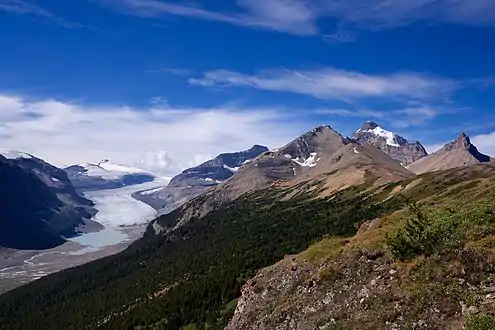Parker Ridge
Parker Ridge is a 2,255-metre (7,398-foot) mountain ridge located in the upper North Saskatchewan River valley in Banff National Park, in the Canadian Rockies of Alberta, Canada. Its nearest higher peak is Mount Athabasca, 7.7 km (4.8 mi) to the west.[1] Parker Ridge is situated along the west side of the Icefields Parkway and southeast of Sunwapta Pass. Parker Ridge is a ski-touring destination in the winter and popular hiking destination in the summer because it is situated beside the Icefields Parkway allowing easy access, and is nearly entirely above treeline allowing good views of the surrounding mountain landscape. A 2.2 km (1.4 mi) trail gains 275 metres (900 ft) of elevation from the highway to the top of the ridge. Wandering east or west along the ridge provides views of Cirrus Mountain, the north face of Mount Saskatchewan, Saskatchewan Glacier, Mount Athabasca, Hilda Peak, and Nigel Peak among others.
| Parker Ridge | |
|---|---|
 Parker Ridge viewed from Icefields Parkway | |
| Highest point | |
| Elevation | 2,255 m (7,398 ft)[1] |
| Prominence | 170 m (560 ft)[1] |
| Parent peak | Mount Athabasca (3491 m)[1] |
| Coordinates | 52°10′51″N 117°05′32″W[2] |
| Geography | |
 Parker Ridge Location of Parker Ridge in Alberta  Parker Ridge Parker Ridge (Canada) | |
| Location | Alberta, Canada |
| Parent range | Canadian Rockies |
| Topo map | NTS 83C3 Columbia Icefield[2] |
| Geology | |
| Type of rock | Sedimentary |
| Climbing | |
| Easiest route | Hiking |
History
Parker Ridge was named for Elizabeth Parker (1856–1944), co-founder of the Alpine Club of Canada in 1906 along with Arthur Oliver Wheeler. The Elizabeth Parker hut near Lake O'Hara in Yoho National Park is also named in her honor.[3]
The mountain's name was officially adopted in 1978 by the Geographical Names Board of Canada.[2]
Geology
Like other mountains in Banff Park, Parker Ridge is composed of sedimentary rock laid down from the Precambrian to Jurassic periods.[4] Formed in shallow seas, this sedimentary rock was pushed east and over the top of younger rock during the Laramide orogeny.[5]
Climate
Based on the Köppen climate classification, Parker Ridge is located in a subarctic climate with cold, snowy winters, and mild summers.[6] Temperatures can drop below -20 °C with wind chill factors below -30 °C. Precipitation runoff from Parker Ridge drains into tributaries of the North Saskatchewan River.
References
- "Parker Ridge". Bivouac.com. Retrieved 2019-04-08.
- "Parker Ridge". Geographical Names Data Base. Natural Resources Canada. Retrieved 2019-04-08.
- "Elizabeth Parker Hut". Alpine Club of Canada. The Alpine Club of Canada. Retrieved 29 March 2022.
- Belyea, Helen (1960). "The Story of the Mountains in Banff National Park" (PDF). Geological Survey of Canada. Archived (PDF) from the original on 2 October 2015. Retrieved 2019-06-23.
- Gadd, Ben (2008). Geology of the Rocky Mountains and Columbias.
- Peel, M. C.; Finlayson, B. L.; McMahon, T. A. (2007). "Updated world map of the Köppen−Geiger climate classification". Hydrol. Earth Syst. Sci. 11: 1633–1644. ISSN 1027-5606.
Gallery
Views from Parker Ridge
 Castleguard Mountain, Saskatchewan Glacier, Mt. Athabasca, Hilda Peak
Castleguard Mountain, Saskatchewan Glacier, Mt. Athabasca, Hilda Peak Cirrus Mountain from Parker Ridge
Cirrus Mountain from Parker Ridge Overlooking North Saskatchewan River
Overlooking North Saskatchewan River Saskatchewan Glacier and Castleguard Mountain
Saskatchewan Glacier and Castleguard Mountain Mount Athabasca and Hilda Peak from Parker Ridge trail
Mount Athabasca and Hilda Peak from Parker Ridge trail Mount Woolley and Diadem Peak in the distance
Mount Woolley and Diadem Peak in the distance Looking east at unnamed ridge
Looking east at unnamed ridge View from Parker Ridge of Nigel Peak's outliers
View from Parker Ridge of Nigel Peak's outliers
External links
- Parks Canada web site: Banff National Park
- Weather: Parker Ridge